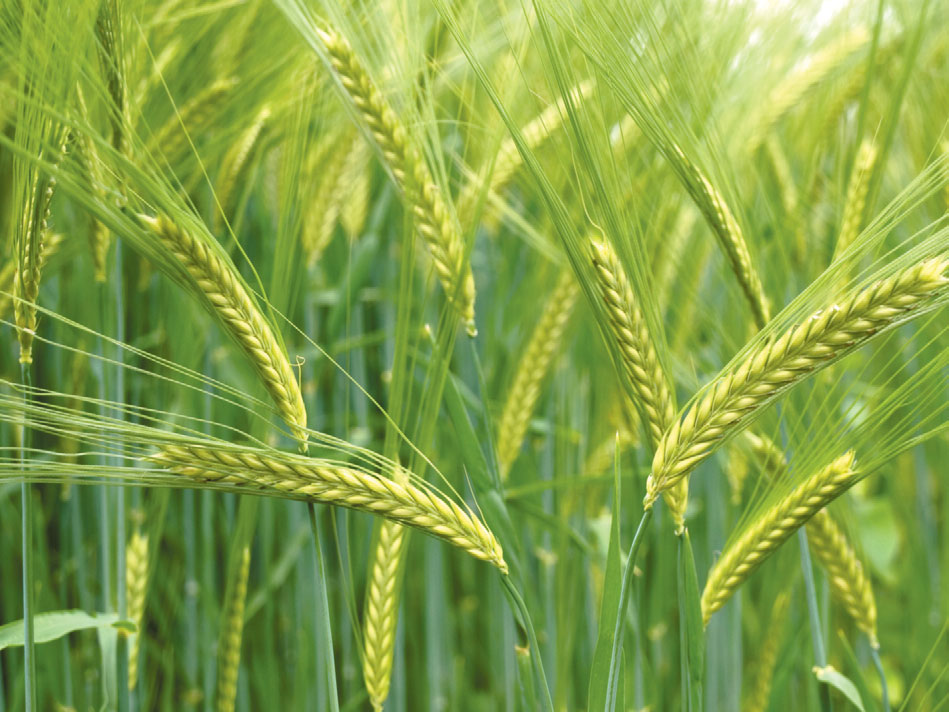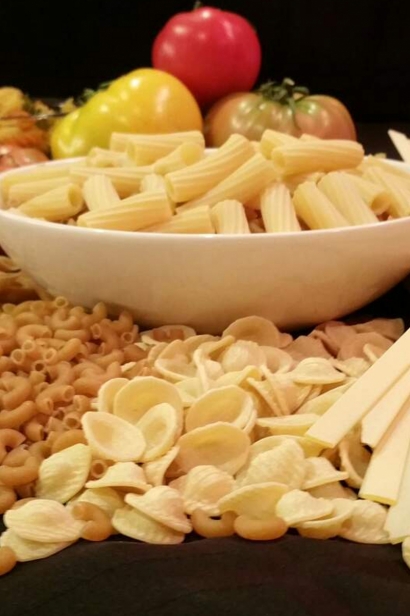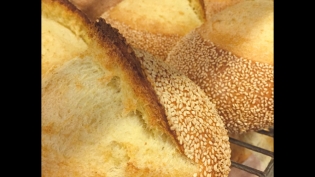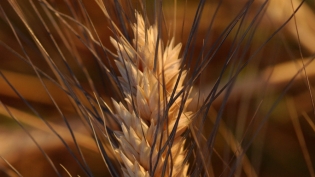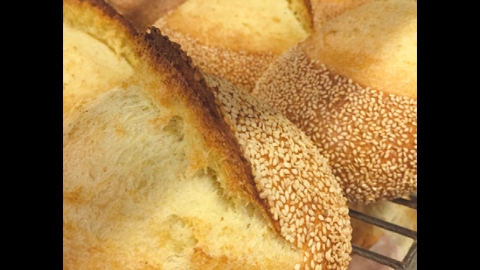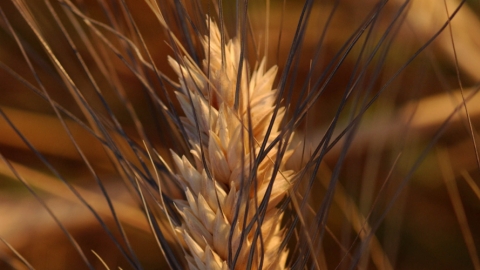Durum Wheat
ARIZONA’S GEM OF THE SOUTHWEST
When you think of the crops grown in Arizona, cotton and citrus come to mind. But what many people do not know is that there is a highly regarded wheat industry in the state—one that has become extremely attractive to pasta makers in the United States, Europe and even parts of Africa.
Wheat is the third-most-grown crop in the United States, after corn and soybeans. In fact, about 55 million acres are seeded annually. That’s about the size of the entire state of Oregon. To most people, flour is flour and is made from some generic plant called “wheat.” However, not all wheat is created equal. There are in fact many different kinds of wheat grain that are milled into flour. What kind of grain is used depends on the final use of the flour.
Six major market classes of wheat are grown in the United States. Hard red spring is great for crusty hearth bread while hard red winter is excellent for yeast breads. Soft red winter is used for cakes and pastries, soft white spring for flatbreads and a relative newcomer, hard white winter is best for Asian noodles and wheat breads.
The sixth class, durum, is the hardest wheat, making it ideal for milling into semolina to make those delicious pasta shapes that we all love. Durum wheat has long been grown in the United States in North Dakota, Montana and surrounding states. However, in the low deserts and river valleys of Southern Arizona and Southern California, a relatively new version of this crop is grown, called Desert Durum®.
The term “Desert Durum” has been trademarked by the California Wheat Commission and the Arizona Grain Research and Promotion Council (AGRPC), which is affiliated with the Arizona Department of Agriculture. Allan Simons, executive director of the AGRPC, indicates that in order to be classified as Desert Durum, the grain must have been grown under irrigation in the low desert areas of Arizona and Southern California.
In farms near Phoenix, Casa Grande and Tucson, decisions to plant the crop are often based on supply and demand: If the demand is high and the price is high, farmers grow it. In Yuma County, an area that consistently grows produce, wheat is also seen as a rotational crop. Desert Durum is usually planted November through February and harvested in May through early July, up to three months ahead of the spring durum crops harvested in other areas of the country.
Most Desert Durum is brought to market by grain-handling firms, such as Arizona Grain Inc. in Casa Grande, and Barkley Seed Inc. and Dunn Grain Inc. in Yuma. The grain handlers take orders from their customers, predominantly domestic and international millers and pasta makers, in the fall. They then contract with farmers to grow the grain to fill the orders. The grain is stored and delivered throughout the year in accordance with the customers’ needs.
Up to half of the annual Desert Durum crop is exported. Italian customers are the largest importers, but a Nigerian mill has also been a big user. Some of the remaining crop stays in Arizona, where Massachusetts-based Bay State Milling mills the grain in their Tolleson plant and transfers the flour across the street to American Italian Pasta Company, a division of ConAgra, which sells its pasta in grocery stores under several brand names, such as Heartland (Walmart), Golden Grain (Winco) and Anthony’s (El Super). Significant volumes of Desert Durum grain are also shipped to other domestic mills.
Desert Durum’s Trademarked Identity
What makes Desert Durum so unique and highly regarded that it is deserving of a trademarked identity?
The quality of durum wheat is partially determined by the strength of its gluten protein content, as well as the shape, color and consistency of the grains. Desert Durum possesses traits that are highly valued by mill operators, pasta makers and all of us who enjoy a good spaghetti dinner. These traits result from a combination of an ideal climate for growing durum wheat and skilled plant breeders who continually develop and release new varieties of Desert Durum wheat.
Steve Sossaman, owner of Sossaman Farms in Queen Creek, states that “Arizona’s Desert Durum is the highest-quality durum wheat in the world and the reason for that is the growing conditions here in the desert.”
Our dry climate, cool winter nights and warm, sunny days, combined with precise fertilization and irrigation practices, are ideal. Rainfall during the harvest period can cause the wheat to sprout and/or lose color; but that is not usually a problem in Arizona, as the wheat is harvested in May and June, when rainfall is rare. The desert environment produces a very large seed with very low moisture content. In fact, at the time of harvest, the moisture content of Desert Durum is about 7%, barely half that of the durum wheat grown in the northern U.S. and Canada.
Desert Durum has excellent and consistent grain characteristics that millers appreciate. The low moisture content yields more millable wheat per ton purchased. And the uniformly large kernels result in high semolina extraction rates, which means more of the grain is ground into semolina, allowing the milling operation to reach higher yields.
Italian pasta makers love Desert Durum’s bright yellow semolina color, high protein content and especially its strong gluten. Pasta quality is determined by its cooking characteristics. It has to be able to withstand long cook times and, after cooking, the pasta should not be mushy or rubbery, but rather it should retain a firm texture (al dente). The amount of solid material lost in the cooking water, known as cooking loss, should be low. It should retain its shape and not stick together after cooking. Semolina with higher protein and stronger gluten protein produces pasta with better cooking properties.
There are numerous varieties of Desert Durum that have been developed over the years by private plant breeders in Arizona. The varieties most widely grown in Arizona in 2015 were DuraKing, Havasu, Helios, Kronos Orita, Platinum, Tiburon, WB-Mead, WB-Mohave and Westmore HP.
Much of Arizona’s Desert Durum crop is “identity preserved.” This means that the farmers grow and harvest different varieties separately. The varieties’ identities are preserved during storage and shipment. This ensures a buyer who wants a specific variety that his Desert Durum will be pure and uncontaminated by other varieties.
History of Desert Durum
In the 1970s, Arizona’s durum wheat industry was viewed negatively by the pasta industry because of the inconsistent quality, low protein content and poor color of the wheat. In the late ‘70s, according to Simons, much of the Arizona-grown durum wheat was used for animal feed. “[The grains] were not suitable for making semolina for pasta that most people would enjoy.”
In 1974, Dr. Al Carleton, a grain breeder in Montana, partnered with Arizona seedsman Bill Corpstein and others to found Western Plant Breeders. Their goal was to produce a durum wheat that would result in a greater yield of high-quality grain. They crossed high-quality northern varieties with some high-yielding varieties known to grow well in the Southwest desert. One of the new varieties was dark yellow in color, much different from anything previously grown in the Southwest. Eventually named WestBred 881, early samples of pasta made from its semolina were sent to the USDA facility in Fargo. Due to the deep yellow color, the plant breeders were accused of doctoring the sample with eggs.
The next step was getting the attention of the pasta makers. Some samples were sent to potential Italian customers and, eventually, in the mid-’80s, an Italian pasta maker began purchasing significant quantities of the WestBred 881 variety. Since then, plant breeders have developed many varieties of similarly high-quality durum wheat to meet market and regulatory demands.
An Industry Under Attack
In March of 1996, the disease Karnal bunt was discovered for the first time in the United States in central Arizona wheat fields, and in wheat fields along both sides of the Colorado River south of Parker. Karnal bunt is a fungal disease of wheat, first reported in wheat-growing areas near the city of Karnal, India. The rare fungus is not harmful to humans but it has the potential to reduce grain quality. If the infestation is bad enough, it can make flour smell bad and taste unusual. Furthermore, numerous countries have restrictions against importing wheat contaminated with Karnal bunt. Upon discovery of the disease, the U.S. Department of Agriculture’s main objective was to prevent the disease from spreading to other wheat-producing states and to protect the $5 billion U.S. wheat export program.
The USDA declared an emergency and immediately quarantined the entire state of Arizona, several counties in New Mexico and California, and restricted movement of grain and other materials and equipment that might spread the spores. In addition, a nationwide testing program was implemented to determine exactly where the disease was found and assure our trading partners that U.S. wheat exports were free of Karnal bunt. To date, no evidence of the disease has been found in areas other than those identified initially.
The government response was temporarily devastating to Arizona’s wheat industry. Many farmers felt that the government reaction was overblown and likened it to swatting a mosquito with a sledgehammer. Many lost their entire crop that year and many more decided not to grow Desert Durum in the future. Grain handlers lost orders even though the farmers they were representing had no incidences of Karnal bunt.
The good news is that, over time, a sampling and testing process has allowed most wheat fields to be released from restriction. Karnal bunt quarantine regulations require that wheat fields in restricted areas be tested prior to harvest. In 2015 there were approximately half a million total acres under restriction, all located in parts of La Paz, Maricopa and Pinal Counties. In those areas, wheat was planted on 22,499 acres. In 2015, 36 wheat fields totaling 2,094 acres tested positive for the disease, whereas fewer than five fields had tested positive in recent years. The sudden increase in positive tests was attributed to unusual and untimely showers during the wheat flowering period. Grain from fields that test positive for Karnal bunt must be treated and used as animal feed. If Karnal bunt tests are negative for five years, individual fields can become deregulated.
Looking to the Future
Tim Dunn, owner of Tim Dunn Farms and Dunn Grain Company in Yuma County, says that Desert Durum will continue to be “one of the most sought-after wheats in the world. It is water-efficient and water-wise, which makes it a great rotation crop for Arizona farmers.”
In 2014, Arizona produced more than 217,000 metric tons of Desert Durum and the 2015 crop is expected to be 50-75% larger than last year, due largely to increased milling industry demand caused by weather-related quality issues in the 2014 northern U.S. durum crop. Because of the increase in demand, this year’s crop fetched prices up to 50-75% higher last year.
Even with the “gluten free” craze sweeping the nation, pasta is still a $3 billion industry. With superior seeds, the perfect climate and controlled irrigation, it’s no wonder the Desert Durum industry is booming—here in Arizona.


